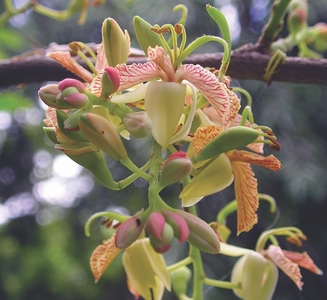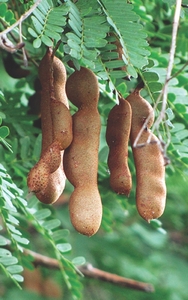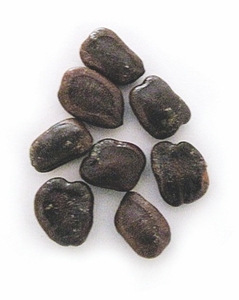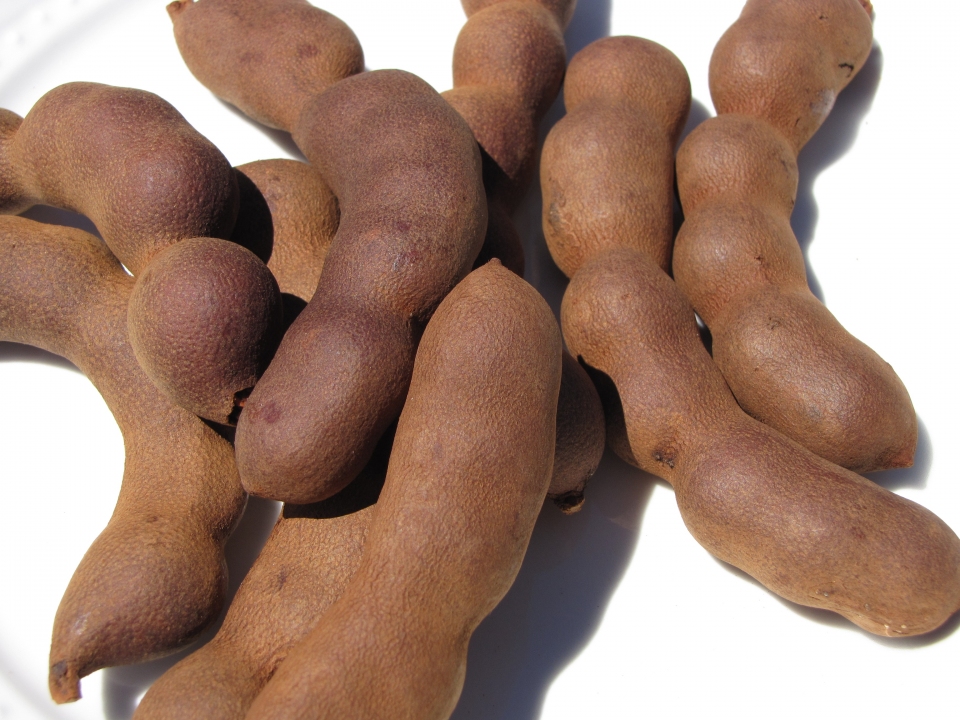
Tamarindus indica L. - tamarind

Tamarindus indica L. - tamarind

Tamarindus indica L. - tamarind

Tamarindus indica L. - tamarind

Tamarindus indica L. - tamarind

Tamarindus indica L. - tamarind
| Plant Category | : | Tree |
| Melghat's Flora's Serial No. | : | 178 |
| Synonym | : | Tamarindus occidentalis Gaertn.;
Tamarindus officinalis Hook.;
Tamarindus umbrosa Salisb.; |
| Plant Common Name | : | Chinch, Imli, K-Chincha, G-Sitta, Tamarind • Hindi: Imli • Bengali: Amli • Manipuri: Mange • Tamil: Puli • Telugu: Chinta • Marathi: Chinch |
| Plant Family | : | Fabaceae |
| Description | : | Trees, to 20 m high, bark brown to brownish-black, rough with vertical fissures; branchlets warty, tomentose. Leaves paripinnate, alternate; stipules lateral, minute, cauducous; rachis 8-13 cm long, slender, glabrous, pulvinate; leaflets 20-34, opposite, sessile, estipellate; lamina 1.5-4 x 0.4-1.3 cm, oblong, base unequal, apex obtuse, margin entire, glabrous, chartaceous; lateral nerves 10-15 pairs, pinnate, slender, obscure, looped at the margin forming intramarginal nerve; intercostae reticulate, obscure. Flowers bisexual, 1 cm across, yellow with reddish-pink dots, in lax terminal racemes; bracts and bracteoles ovate-oblong, coloured, cauducous; pedicels upto 5 mm; calyx tube narrowly turbinate, lined by disc; lobes 4, subequal, oblong, imbricate; petals 3, outer one, 1 x 0.3 cm, rolled up, pink dotted, lateral 2, 1-1.5 x 0.7-1 cm, clawed, subequal, oblong-lanceolate, lower pair scaly; stamens 9 monadelphous, only 3 fertile, others reduced to bristle, base pubescent; anthers versatile; ovary half inferior, stipitate, adnate to the disc, ovules many; style attenuate, tomentose; stigma globose. Fruit a pod 10-15 x 1-2 cm, oblong, fruit wall crustaceous, mesocarp pulpy, endocarp septate, leathery, indehiscent; seeds 3-8 or more, obovoid-orbicular, compressed, brown. |
| Plant Location in Melghat | : | Only at village sites |
| Medicinal Use / Activity | : | The bark is astringent and tonic and its ash may be given internally as a digestive. Incorporated into lotions or poultices, the bark may be used to relives sores, ulcers, boils and rashes. It may also be administered as a decoction against asthma and amenorrhea and as a febrifuge. Leaf extracts exhibit anti-oxidant activity in the liver, and are a common ingredient in cardiac and blood sugar reducing medicines. Young leaves may be used in fomentation for rheumatism, applied to sores and wounds, or administered as a poultice for inflammation of joints to reduce swelling and relieve pain. A sweetened decoction of the leaves is good against throat infection, cough, fever, and even intestinal worms. The filtered hot juice of young leaves, and a poultice of the flowers, is used for conjunctivitis. The leaves are warmed and tied to affected areas in order to relieve swellings and pains, particularly sprains. They are also used for bathing sores or to bathe persons suffering from measles or allergies. The leaves and flowers are used to make a sweetened tea that is drunk by children as a remedy for measles. They were also used in a preparation which was drunk in early Guyana as a malaria remedy. A decoction of the flower buds is used as a remedy for children's bedwetting and urinary complaints. The fruit is aperient and laxative. A syrup made from the ripe fruit is drunk in order to keep the digestive organs in good condition, and also as a remedy for coughs and chest colds. The flesh of the fruit is eaten to cure fevers and control gastric acid. The fruit pulp may be used as a massage to treat rheumatism, as an acid refrigerant, a mild laxative and also to treat scurvy. Powdered seeds may be given to cure dysentery and Diarrhea. The plant contains pyrazines and thiazoles. The seed contains polyoses. The bark yields proanthocyanidin and hordenine. It is used traditionally in abdominal pain, Diarrhea and dysentery, helminthes infections, wound healing, malaria and fever, constipation, inflammation, cell cytotoxicity, gonorrhea, and eye diseases. |
| Plant's Phytochemicals | : | COMPOUNDS: L-(-)mallic acid; tartaric acid; tartaric acid; acetic acid; citric acid; formic acid; malic acid; succinic acid; lupanone; lupeol; linonene; benzyl benzoate; n-hexacosane; eicosanoic acid; beta-sitosterol; octacosanyl ferulate; 21-oxobehenic acid; (+)-pinitol; almitic acid; oleic acid; linoleic acid; eicosanoic acid; beta-amyrin; compesterol; apigenin; catechin; procyanidin B2; epicatechin; procyanidin dimer; procyanidin trimer; taxifolin; eriodictyol; naringenin; ACTIVE COMPOUNDS (8): Lupeol; Beta-sitosterol; Apigenin; Eriodictyol; Naringenin; Catechin; Epicatechin; Taxifolin; |
| Plant's Current Status | : | - |
| Plant's Cross Database Reference | : | 259142 |
| Reference | : | Dhore M. A. (1984) The flora of melghat tiger reserve
- https://indiabiodiversity.org/species/show/31829
- http://tropical.theferns.info/viewtropical.php?id=Tamarindus+indica
- http://www.flowersofindia.net/catalog/slides/Tamarind.html
- https://www.ncbi.nlm.nih.gov/pmc/articles/PMC3210002/ |
| Reference | : | ~ Jennifer L. McCracken, Sreenivas P. Veeranki, Bill T. Ameredes, William J. Calhoun; "Diagnosis and Management of Asthma in Adults - A Review"; JAMA (2017); 318(3): 279-290 PMID : 28719697 ~ Chellaiah Muthu, Muniappan Ayyanar, Nagappan Raja and Savarimuthu Ignacimuthu; "Medicinal plants used by traditional healers in Kancheepuram District of Tamil Nadu, India"; Journal of Ethnobiology and Ethnomedicine (2006); 2(43): 1-10 PMID : ~ Pinar Kuru; "Tamarindus indica and its health related effects"; Asian Pac J Trop Biomed (2014); 4(9): 676-681 PMID : ~ Chen S; "Natural products triggering biological targets - a review of the anti-inflammatory phytochemicals targeting the arachidonic acid pathway in allergy asthma and rheumatoid arthritis."; Curr Drug Targets (2011); 12(3): 288-301 PMID : 20955151 ~ Park HS, Kim SR, Kim JO and Lee YC; "The roles of phytochemicals in bronchial asthma"; Molecules (2010); 15(10): 6810-34 PMID : 20924320 ~ Santosh Kumar Singh, Jay Ram Patel, Prashant Kumar Dubey and Sonia Thakur; "A review on anti-asthmatic activity of traditional medicinal plants"; IJPSR (2014); 5(10): 4109-4116 PMID : ~ R.N. Kale, R.N. Patil and R.Y. Patil; "Asthma and Herbal Drugs"; IJPSR (2010); 1(12): 37-42 PMID : ~ Balaji Kasirajan, Rajadurai Maruthamuthu, Vidhya Gopalakrishnan, Krithika Arumugam, Hudson Asirvatham, Vidya Murali, Ramya Mohandass and Anusha Bhaskar; "A database for medicinal plants used in treatment of asthma"; Bioinformation (2007); 2(3): 105-106 PMID : ~ J. Lenin Bapuji and S. Venkat Ratnam; "Traditional Uses of Some Medicinal Plants by tribals of Gangaraju Madugula Mandal of Visakhapatnam District, Andhra Pradesh"; Ethnobotanical Leaflets (2009); 13: 388-98 PMID : ~ Dhore MA and Joshi PA; "Flora of Melghat Tiger Reserve"; Directorate, Project Tiger, Melghat (1988); PMID : ~ Omesh Bajpai, Jitendra Pandey and Lal Babu Chaudhary; "Ethnomedicinal Uses of Tree Species by Tharu Tribes in the Himalayan Terai Region of India"; Research Journal of Medicinal Plant (2016); 10(1): 19-41 PMID : ~ Das, DC.; Sinha, NK.; Chattopadhyay JC.; Das M. and Samanta P.; "The use of medicinal plants for the treatment of Gonorrhea and Syphilis in south west Bengal of India"; International Journal of Phytomedicine (2013); 5: 14-17 PMID : ~ Rajendra Prasad Bharti, Abhilasha shrivastava, Jagjeevan Ram Choudhary, Asha Tiwari and N. K. Soni; "Ethno Medicinal Plants used by Tribal Communities in Vindhya region of Rewa and Sidhi District of Madhya Pradesh, India"; IOSR Journal of Pharmacy and Biological Sciences (2013); 8(6): 23-28 PMID : ~ Kavishankar, G.B; Lakshmidevi, N.; Murthy, S.M.; Prakash, H.S. and Niranjana, S.R.; "Diabetes and medicinal plants-A review"; Int J Pharm Biomed Sci (2011); 2(3): 65-80 PMID : |
| Kingdom | : Plantae - Plants |
|---|---|
| Phylum | : Tracheophyta |
| Subkingdom | : Tracheobionta - Vascular plants |
| Superdivision | : Spermatophyta - Seed plants |
| Division | : Magnoliophyta - Flowering plants |
| Class | : Magnoliopsida - Dicotyledons |
| Subclass | : Rosidae |
| Order | : Fabales |
| Family | : Fabaceae / Leguminosae - Pea family |
| Genus | : Tamarindus L. - tamarind |
| Species | : Tamarindus indica L. - tamarind |